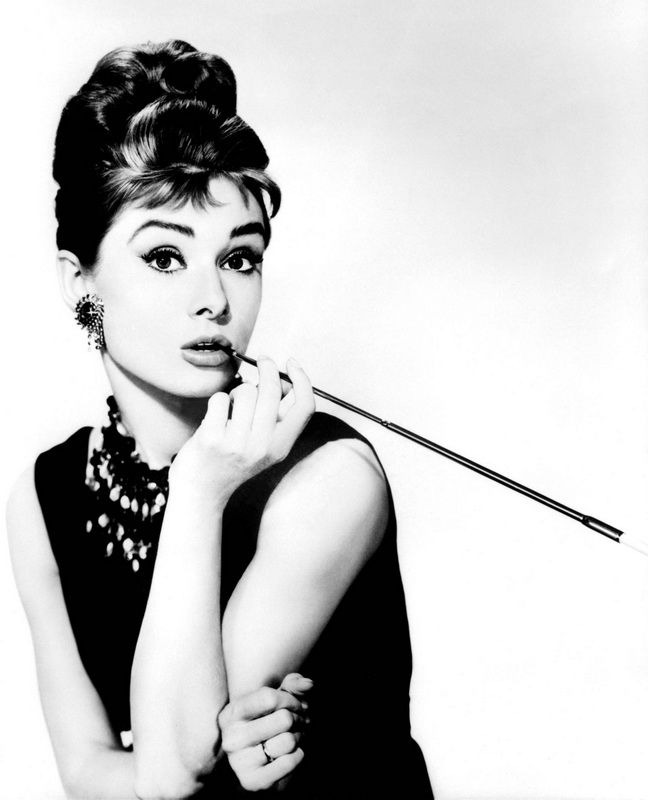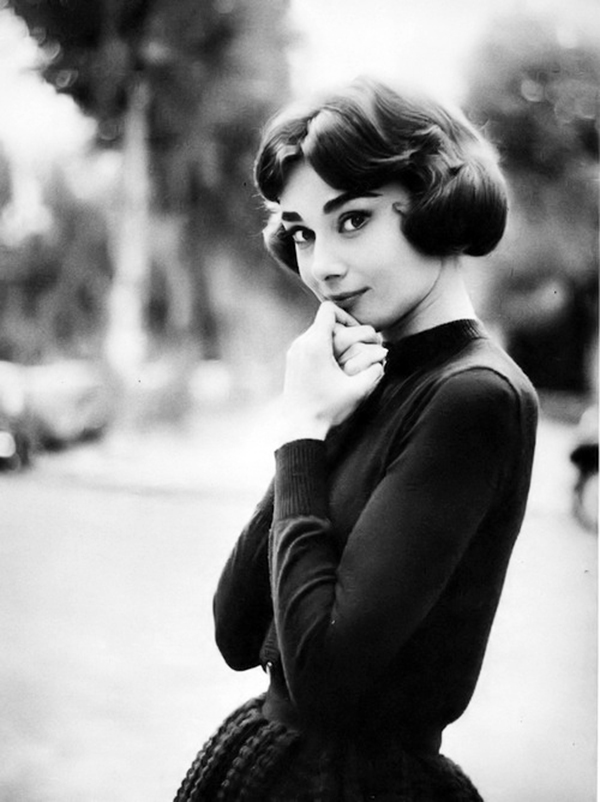And that's the point. Those iconic still images of Audrey Hepburn are what she is remembered for, not the necessarily the movies they come from. Think of the iconic picture of Hepburn from her film, The Nun's Story. You know the one. Hepburn in an elegant black dress, her neck covered in pearls, a foot long cigarette holder in her silk gloved hand, her poise and beauteous charm the embodiment of sophistication and grace.
 |
| That's the one. |
The image and idea of Hepburn is so detached from the films she starred in, that half of you didn't know this photo is actually from her most famous role, Breakfast at Tiffany's. The other half are angry I tried such an obvious ploy, shaking your heads in disapproval, despite the fact you probably haven't seen the movie.
I know I hadn't. At least until I watched it as part of the research for this article. Of course, I knew who Audrey Hepburn was. I've seen the images from Breakfast at Tiffany's too. I was aware she was an actress long before I was born and was an icon of glamour and elegance.
But I had never watch one of her movies. And aside from Tiffany's, I don't think I could easily recall any other movie she'd starred in of the top of my head. She just was those images. The image of style and grace. A slender slip of a woman who was strikingly stunning and pretty with a girlish charm under all the sophistication.
 |
| And she could be irresistibly cute when she wanted to be. |
And that's the thing. She projected such an image of sophistication and style that it overwhelm her star persona until it was turned into a meme. Always known for her fashionable tastes, by the time the internet came around, her iconography was solidified.
An iconography of timeless grace that could be fetishised into a series of pictures which projected a certain image of sophisticated stylish charm that people, predominantly young girls, could look up to and admire. An iconography which could be easily disseminated online until the mere sight of a picture of Hepburn carried with it connotations far beyond any role she occupied in her career.
She became more than just an actress from another era immortalised in film and pictures, she became the embodiment of a certain sensibility, carrying with it a host of meanings but pointing to one thing, an ideal of feminine style which one could aspire to and be inspired by.
 |
| "Who me, darling?" |
It also helped that Hepburn said a lot of charming and sophisticated things about life, because of course she did. These have often been plastered on images of her, adding to the ideology and iconography she came to represent.
Things like,
For beautiful eyes, look for the good in others; for beautiful lips, speak only words of kindness; and for poise, walk with the knowledge that you are never alone.And,
The beauty of a woman is not in the clothes she wears, the figure that she carries or the way she combs her hair.Or,
People, even more than things, have to be restored, renewed, revived, reclaimed, and redeemed; never throw out anyone.
 |
| Not to mention, "If you've got it, flaunt it" (citation needed). |
As those quotes clearly illustrate, the poise which Hepburn embodied in her iconography was paired with life advice which stressed the secret to being beautiful and sophisticated wasn't how you dressed or looked. Rather it was the manner in which you presented yourself through confidence, your own happiness, and through bringing happiness to others.
On a near complete tangent, I've noticed that often when celebrities or movie characters say seemingly wise, bite-sized quotes about life, people seem to take those quotes as a valid life philosophy. Even if that life advice doesn't actually make sense when you really think about it. This isn't to discredit Hepburn's words but is more a wider comment on the validity we give to bite-sized quotes which simplified life into easily manageable 'truisms'.
My favourite example is Yoda's "Do or do not. There is no try." That literally makes no sense. Of course there is try. Trying leads to doing. You can't just do something without trying it first. That is the meaning of the word, Yoda. Jeez.
 |
| "Bad my. Goof that time I did." |
Now from our privileged position decades after Hepburn said those words, it seems almost condescending, at worst hypocritical, for one of the most beautiful actresses of all time to declare that beauty isn't about how one looks but how one looks at others. As if looking for the good in others will make my eyes more beautiful, the skeptic would say.
Especially since Hepburn seems to present a type of beauty which now appears near unattainable. Incredibly thin but tall, with a gorgeous face and an infectious smile framed by a distinctive profile and prim thick eyebrows, Hepburn presents an almost impossible standard of female beauty.
However, what I think has been forgotten over time is just how different Hepburn was when she started on the scene and how she was a drastic alternative to the voluptuous curvy women who had been dominating the silver screen at the time. Being skinny wasn't seen as desirable or in vogue for a female film star back in the 1950s, an era dominated by Elizabeth Taylor, Jane Mansfield, and of course, Marilyn Monroe.
 |
| And then comes along this impossibly adorable wisp of a girl. |
When Audrey Hepburn made her start on the silver screen with Roman Holiday in 1953, she offered an alternative form of beauty, one that wasn't defined by a lady's bust or curves but her grace and poise. Rather than perpetuating the idea that there was only one ideal female body type, Hepburn presented the idea that alternative body types can be beautiful and glamorous too.
Unfortunately, that seems to have been lost over the years as we've had decades of models and film actresses literally starving themselves to attain the remarkably slender form with which Hepburn moved so elegantly across the screen.
Hepburn's thin frame was actually a result of adolescence malnutrition during World War 2, not a conscious attempt on her part to be skinny in order to be considered attractive. Luckily, Hepburn had an acute sense of what looked good on her, clothes which accentuated her assets and downplayed her 'flaws', like her lack of impressive cleavage.
 |
| Who needs boobs when you're this elegant? |
However, in providing an alternative to the bodacious bomb-shells onscreen at the time, rather than showing that all body types are beautiful in their own way, over time Hepburn herself become an ideal vision of feminine beauty which seemed just as unattainable as the one presented by Elizabeth Taylor.
It doesn't help she was the original manic pixie dream girl. For those who might not be familiar with the term, a manic pixie dream girl is female character in a movie who exists solely as the ideal girl for the protagonist. Slightly quirky yet adorable, sharing many of the same interests yet infinitely interesting, able to hang out with his friends as one of the boys yet unmistakably attractive and feminine.
Think Zooey Deschanel in (500) Days of Summer, or actually pretty much most of her filmography. Or think about the term which was created to describe Deschanel's acting persona, adorkable. Because she's an adorably dork and dorkly adorable. Attractive yet approachable. Now, while Hepburn was too graceful to ever be adorkable you can see how she trailed the way for the manic pixie dream girls to follow.
 |
| This is my favourite image of Hepburn precisely because it is so manic pixie dream girlish. |
So when I read that Audrey Hepburn was the inspiration for Joy in Inside Out it made perfect sense to me. Hepburn could be boundlessly joyful, indeed a large part of her charm in Roman Holiday as Princess Ann is how boundlessly energetic and curious she is, trying to get the most of a day without royal engagements and a schedule.
I had intended to write about how Hepburn's films are often ignored in light of her image or the connotations associated to her image eventually getting round to reviewing some of her films. However, I've only watched her first film, Roman Holiday, and her most well-known film, Breakfast at Tiffany's, both of which have been discuss elsewhere online in great depth.
 |
| "What have they been saying?" |
And it's an interesting thing but the truth is that Hepburn's image carries so much with it, style, grace, beauty, wisdom, sophistication, and so on, that it really is a story in and of itself. One that is just as rich as the wonderful characters she played in the couple dozen movies she made (a large number of which have become undeniable classics).
I think that Hepburn was a fantastic actress deserving of the accolades she was given based on the few films of hers I have seen but the greatest role she played was one she never auditioned for nor meant to play. That was the role of ideal feminine beauty which young girls either aspired to or felt was unattainable.
However, one can hope that the image of graceful elegance and sophisticated beauty she represents ultimately leads to furthering the belief that all body types are beautiful.
For after all, Audrey believed that happy girls are the prettiest girls.
References:
Audrey Hepburn Wikipedia page
6 Lesser-Known Facts About Audrey Hepburn - Biography.com
Roman Holiday Wikipedia Page
Audrey Hepburn’s Son: My Mother Never Thought She Was Beautiful - Vanity Fair
Audrey Hepburn Was the Inspiration for Inside Out’s Joy - Vulture
No comments:
Post a Comment